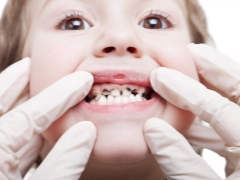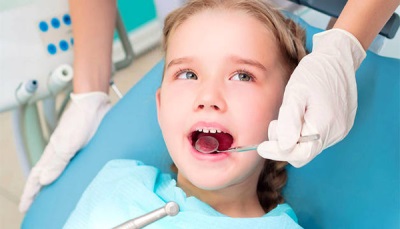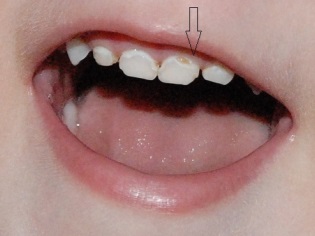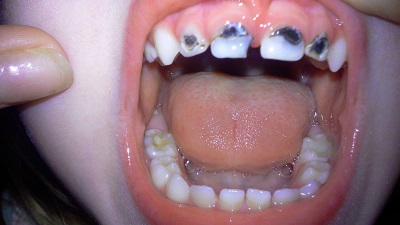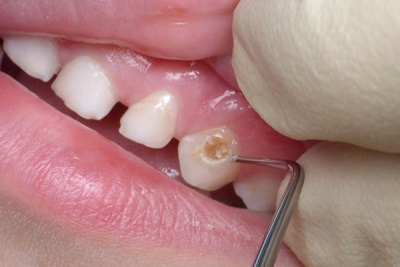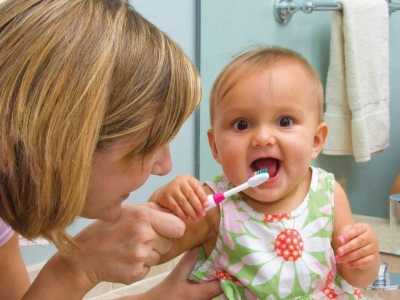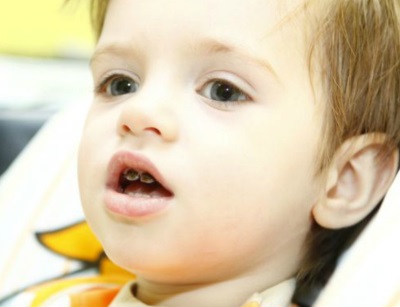Baby tooth decay
Any parent would like his child's teeth to be strong and not hurt. However, in reality, about 70% of children suffer from diseases such as caries. In this case, in half of the cases, parents turn to the dentist when the teeth are very deeply affected or complications appear.
The reasons
The appearance of caries in children is associated with the simultaneous influence of several factors, among which the most significant ones are considered:
- Poor oral hygiene. If a child doesn’t brush its teeth well enough or doesn’t clean it at all, there will be pieces of food on the teeth, in which bacteria are actively breeding.
- Excess carbohydrate food in the diets. Carbohydrates are used by the baby as a source of nutrition.
- Genetic predisposition.
- Shortage in the diet of food crumbs, which requires intensive chewing. Because of this chewing, saliva rises, as a result of which the teeth are cleaned naturally.
- The lack of calcium and fluoride in food and water consumed by the child.
- Due to physiological reasons, the low resistance of dental tissues in children to bacteria that cause caries.
- Rickets, because of which tooth tissue is destroyed faster.
- Long-term use for food and drink bottles. While the child sucks food, it lingers on the teeth for a long time, and drinking compote or juice at night provokes damage to the enamel on the child's front teeth (such caries is called bottle).
- Malocclusion
- Chronic infections, due to which the body's resistance to bacteria decreases.
- Diseases of the mother during the laying of the teeth of the fetus.
Symptoms and signs
When caries only begins to develop on baby teeth, it looks like a white (chalky) spot. There are no other symptoms at this early stage. As the disease progresses, the spots darken, cavities begin to form in the teeth. An unpleasant smell appears from the child’s mouth Toddlers begin to complain of pain when chewing, as well as when eating certain foods (sour, sweet, very hot or cold).
How to recognize caries in time?
It is quite difficult to detect the disease at an early stage, because most parents do not notice white spots on children's teeth, and even the dentist sometimes needs additional methods to identify them, for example, staining the teeth with red or blue dye (it paints only the infected tooth tissue).
If the child has already begun to complain that his teeth ache, a visit to the dental office should be prompt. But it is much better if the specialist will inspect the teeth of the crumbs regularly until the moment they start to hurt. Sometimes babies do not complain of pain, but can chew food on one side or categorically refuse certain foods. This, too, should be a reason to show the crumbs to the dentist.
Kinds
Depending on the depth of damage to dental tissues, caries can be:
- Initial.In this stage a white spot is formed, but there is no pain.
- Superficial. The disease covers only enamel, lesions can be light or dark, and pain occurs when eating salty, sour or sweet foods.
- Average. The process extends to dentin, which is often accompanied by pain.
- Deep Infected most of the internal tissues of the tooth.
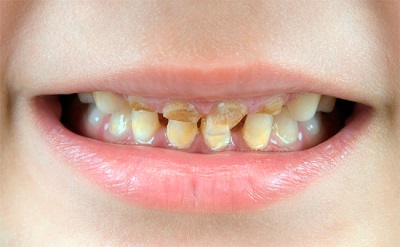
If caries has struck a previously healthy tooth, such a disease is called primary, and if infection develops under the filling, secondary caries is diagnosed. Depending on the occurrence of complications, caries can be uncomplicated as well as complicated. If we take into account the activity of the process, it is allocated decompensated and subcompensated, as well as compensated caries.
When localization is taken into account, the disease is divided into the following types:
- Cervical caries. It is often found in children, covering the area around the neck of milk teeth.
- Approximal caries. In this form, the upper part of the crown is affected. In childhood, it can be planar, when almost the entire chewing surface of molars is affected.
- Fissure caries. The disease penetrates between the teeth.
Do teeth ache during caries?
If the disease has just begun to develop, the child will not have painful sensations. Many babies have no pain even with deep damage to the tooth tissues. Quite often, painful sensations appear only with a certain effect, for example, if caries is superficial, pain may occur when eating sweets or an acidic product.
When caries becomes average, there is a short-term pain from a cold or hot meal. If the infection penetrates deeply, then mechanical action also joins all these stimuli. Then the pains appear when chewing.
Do I need to treat?
Disputes about the need to treat dental caries on baby teeth do not make sense, because the answer is only one - it is necessary to treat teeth. And that's why:
- An infection with no treatment can go so deep that the future permanent tooth will suffer.
- If, due to caries, a tooth falls out ahead of time, the other teeth will move, which can lead to problems with bite and a curved arrangement of permanent teeth.
- Caries can be complicated, and such complications will require urgent treatment, and often also end with tooth extraction.
- The absence of several teeth prevents the child from chewing food properly, as a result of which the child’s digestive tract will suffer.
- A tooth with caries is a source of infection in the child’s body, which reduces its resistance to diseases.
Complications of caries
Most often in children with caries on dairy teeth occurs:
- Pulpitis. The lesion extends deep into the soft tissues of the tooth, called pulp. The child complains of sharp pain in the teeth, as well as increased sensitivity to sweets, hot and cold dishes. Pain may occur during chewing and during sleep.
- Periodontitis The infection passes to the tissues under the tooth, including bone tissue. The baby suffers from severe pain, he has a fever and swelling of the face, called flux.
See how to deal with caries in the next video.
Treatment methods
What substances do cover teeth for protection?
If the disease was detected at an early stage, a drill will not be needed. In the simplest cases, remineralization is used, during which plaque is removed from the teeth, after which the teeth are coated with a special compound rich in calcium, fluorine and phosphorus. This composition helps to restore the integrity of the enamel, and will also be protected from harmful external influences.
One application will protect the teeth for about six months, and then the procedure is repeated.This treatment is widely used for superficial caries. The stain itself, as a rule, is not removed, but its size and severity decrease. Remineralization will also help out in situations where it is difficult for the doctor to determine whether the baby has caries or the tooth enamel is not completely mineralized.
The second common method used in babies is silvering. After cleaning the tooth, it is covered with silver to form a protective film and a bactericidal effect. The procedure is repeated after six months, but it has a significant minus - the treated teeth darken and remain dark until they fall out.
Other non-contact methods used in the treatment of children's caries are laser therapy (helps to remove the affected areas of enamel), ozone therapy (used to disinfect a tooth), and dissolving infected tooth tissues with special chemicals.
Filling and anesthesia
In a situation where the caries struck the teeth deep enough, it is impossible to do without filling. A drill is used to scrub infected tissues from a tooth, and anesthesia is required only when removing the pulp. However, it is often local and is represented by applying an anesthetic gel, after which the child is given an injection. If the kid categorically refuses dental care, apply nitrous oxide or general anesthesia.
The nitrogen inhaled by the child through the mask relaxes the baby, removes fear and sometimes plunges into sleep, but this drug does not anesthetize, therefore, the baby will be additionally given an injection. General anesthesia in the treatment of caries affected teeth is rarely used, mainly for complications, multiple caries and the inability to persuade a child to treat teeth. In this case, such anesthesia has its own contraindications, therefore, first the child is examined by a pediatrician.
When the carious cavity is cleaned, the baby is installed a seal, which can be temporary (with a drug) or permanent (durable). Most often now use substances that quickly harden under the action of light. Often used and colored fillings that kids like. In case of complications of caries, as a rule, milk teeth are removed.
What if the baby is afraid of doctors?
Unfortunately, not all children's dentists have the right approach to the treatment of children, so the first visits to the doctor can be remembered by the crumbs, as something terrible and painful. In this case, you have to pay attention to the crumb stopped being afraid of the dentist.
Carefully select a clinic for reviews and go with the child on a tour. Let the baby simply inspect everything at the first visit. Tell your child why he needs treatment and how it will be carried out. If persuasion does not help, you will have to resort to general anesthesia.
Opinion Komarovsky
The famous pediatrician calls among the main provocative factors of children's caries not only an excess of sweets in the diet and genetic predisposition, but also the drying out of saliva. Due to insufficient air humidification, saliva in the child’s mouth, according to Komarovsky, begins to dry out and loses its protective properties. And the result may be the activation of bacteria causing caries.
That is why the popular doctor so insists that parents monitor the indoor microclimate and not shackle the child unnecessary. In addition, Komarovsky recognizes the great importance of oral hygiene, and if the teeth have already begun to deteriorate, the well-known doctor advises without delay to go to a specialist - a pediatric dentist.
Prevention
The main way to prevent caries in children of the first years of life is to teach the baby the proper care of his teeth. Cleaning should be done twice a day from the moment the first tooth is cut.
A mother can brush her teeth up to a year using a silicone brush that fits on her finger. Children older than a year need to be shown how to properly clean their teeth, turning this procedure into an interesting game. They get a baby brush, and from 2 years of age they begin to use baby paste.
In addition, trying to reduce the impact and other factors that provoke caries. For example, crumbs in the diet include hard vegetables and fruits, which help to mechanically clean the teeth, and limit the amount of sweet. At night, use only clean water for drinking.
In the next video, the popular doctor Komarovsky will tell you how to properly care for the baby’s oral cavity in order to avoid possible dental problems.
